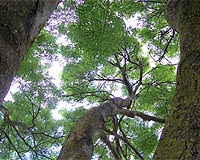| . |  |
. |
Washington DC (SPX) Apr 07, 2010 After increasing during much of the 20th century, forest cover in the eastern United States in recent decades has resumed its previous decline, according to an exhaustive new analysis published in the April 2010 issue of BioScience. The work is described in an article by Mark A. Drummond and Thomas R. Loveland of the US Geological Survey (USGS). During the 19th century and earlier, forests were cleared for agriculture on a large scale, but from around 1920 onward, the eastern United States experienced a net increase in forest cover as fields were abandoned and trees regrew. Experts have been uncertain whether this trend has continued. Drummond and Loveland examined changes in the eastern part of the country from 1973 to 2000 as part of the USGS's Land Cover Trends project, using remotely sensed imagery as well as statistical data, field notes, and ground photographs. Over this time they found a 4.1 percent decline in total forest area, a "substantial and sustained net loss" equivalent to more than 3.7 million hectares. The researchers describe considerable regional variation, with net loss being particularly marked in the southeastern plains. The net loss occurred even though reforestation of abandoned fields and pastures continues, in some regions more than others. Most net forest loss occurs as result of mechanical disturbance of forests for timber production, which keeps some land free of forest, and as a result of urban expansion, which is generally a permanent change. Mountaintop removal for mining in the Appalachian highlands has also had a "substantial impact" on eastern land cover, contributing more than 420,000 hectares of net forest decline. The authors comment that their findings suggest forest transitions may not plateau and stabilize after reaching a point of maximum recovery, which "has important implications for sustainability, future carbon sequestration, and biodiversity."
Share This Article With Planet Earth
Related Links Full text of the article American Institute of Biological Sciences Forestry News - Global and Local News, Science and Application
 Model Predicts Shifts In Carbon Absorption By Forest Canopies
Model Predicts Shifts In Carbon Absorption By Forest CanopiesWashington DC (SPX) Apr 06, 2010 An Agricultural Research Service (ARS) scientist participated in a project to fine-tune computer models that can indicate when forest "carbon sinks" become net carbon generators instead. The results will help pinpoint the effectiveness of trees in offsetting carbon releases that contribute to higher atmospheric temperatures and global climate change. ARS plant physiologist Erik Hamerlynck ... read more |
|
| The content herein, unless otherwise known to be public domain, are Copyright 1995-2010 - SpaceDaily. AFP and UPI Wire Stories are copyright Agence France-Presse and United Press International. ESA Portal Reports are copyright European Space Agency. All NASA sourced material is public domain. Additional copyrights may apply in whole or part to other bona fide parties. Advertising does not imply endorsement,agreement or approval of any opinions, statements or information provided by SpaceDaily on any Web page published or hosted by SpaceDaily. Privacy Statement |